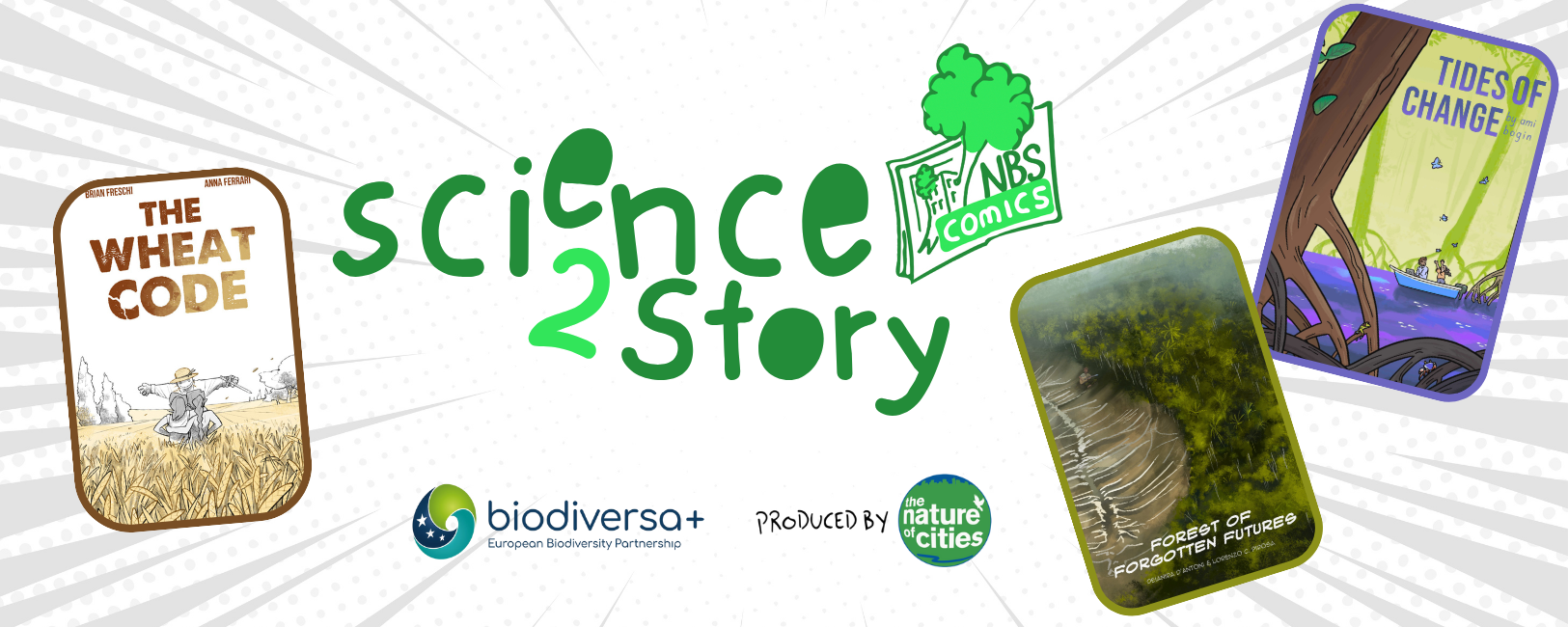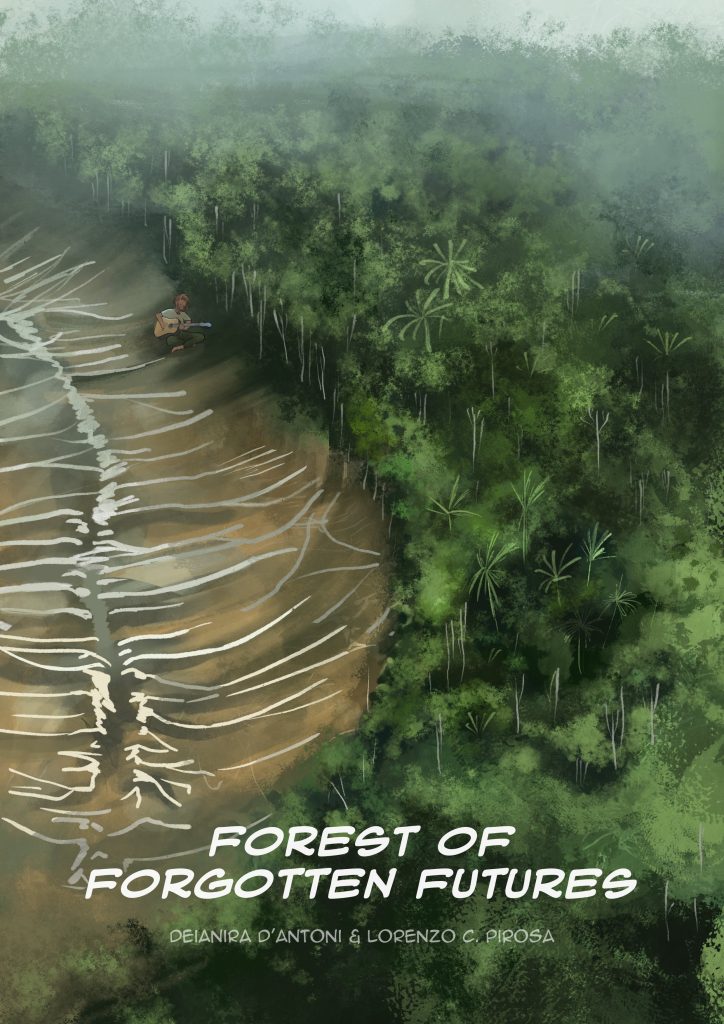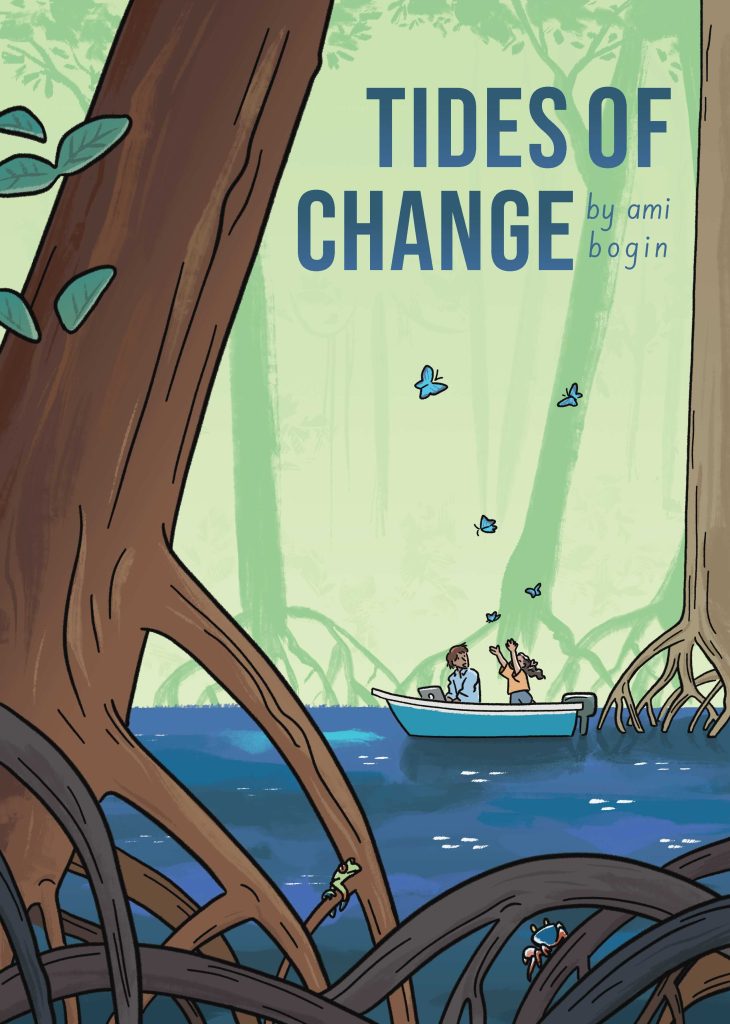Can we use comics to mainstream biodiversity, nature-based solutions, and climate research by telling engaging stories for everyone?
Biodiversa+ and TNOC think so!
So, we partnered to create visual stories based on science projects that Biodiversa+ supports.
Through its BiodivClim COFUND Action, Biodiversa+ launched in 2019 a call — co-funded by the European Commission — to support research on “Biodiversity and climate change”. Twenty-one projects were created and completed in June 2025. We created three comics that tell stories grounded in the science of the projects: on forests, oceans, and agriculture. Hope you enjoy them!
NBS Comics, originally founded by The Nature of Cities and NetworkNature+, with funding from the European Commission, partnered with Biodiversa+ to create three comics based on the BiodivClim COFUND Action’s projects. Each of the 21 projects is represented within one or more comics to better understand their research and how nature-based solutions are important to people. Inside the comics are QR codes that link to more information about the science behind the story.

The Themes of the Call
#1 — Consequences of climate change on biodiversity and nature’s contributions to people
#2 — Climate-biodiversity feedback processes
#3 — Potential of nature-based solutions for mitigating and adapting to climate change
#4 — Synergies and trade-offs between policies on biodiversity, climate, and other relevant sectors, and the role of agents of change
BiodivClim projects in this Science2Story project
ACORN investigates whether forest tree gene pools can adapt to climate change, focusing on oaks (Quercus robur, Q. petraea, and Q. pubescens). It explores assisted gene flow (AGF) by transferring forest reproductive material (FRM) from arid regions to improve drought resilience in trees. The project integrates genetic, physiological, and morphological studies to assess drought tolerance at regional and continental levels. Results aim to inform adaptive FRM guidelines considering climate change impacts. Stakeholder engagement, including policymakers and private businesses, ensures practical applicability and policy relevance.
ASICS explores the impact of climate change and biological invasions on biodiversity in cold environments like polar and alpine regions. By studying species’ physiological adaptations, redistribution, and ecosystem interactions, the project aims to predict and mitigate biodiversity loss. Through experimental approaches, long-term data, and modeling, ASICS seeks to provide tools for environmental management and policy, focusing on risk assessments and strategies to address invasive species and climate-related habitat changes.
BaltVib aims to delineate the current and future Vibrio status, determine biotic and abiotic key factors regulating Vibrio prevalence, and identify nature-based solutions (NbS) to mitigate the problem. This opens up the option for NbS strategies to control pathogenic vibrios in the nearshore habitat where humans interact with the sea.
BIOFAIR focuses on the adaptation of agriculture to climate change, particularly on improving crop resilience, productivity, and quality while conserving soil biodiversity and ecosystem services. The project emphasizes the role of soil microbiome and fauna in nutrient efficiency and disease resistance. Using advanced experiments and field trials, BIOFAIR evaluates innovative farming practices and their effects on wheat growth, quality, and soil health. The outcomes aim to guide future sustainable crop management strategies and inform policies on food security, human health, and environmental sustainability.
CLAMBIO investigates the effects of past and future climate change on Amazonian biodiversity. It aims to understand climate-biodiversity feedback processes, assess the vulnerability of Amazonian species and habitats, and analyze the impacts on indigenous livelihoods. Using sediment cores, species data, and environmental monitoring, the project reconstructs past climate changes, predicts future habitat suitability, and highlights vulnerable areas. Collaboration with indigenous communities ensures the research supports local rights and mitigates climate impacts on their livelihoods.
EASMO will investigate for the first time the impact of climate change on the distribution of reef fish throughout the Eastern Tropical Pacific Ocean (ETP) considering cascading effects on biodiversity, ecosystem function, reefs’ contributions to people, climate feedbacks, and socio-economic wellbeing. Ultimately, it will deliver several layers of new scientific knowledge that can be directly integrated into decision-making tools, support adaptive transboundary governance approaches, and propel actions for meeting the UN Sustainable Development Goals 2 Zero hunger, 13 Climate action, and 14 Life below water.
EPICC applies a polycentric governance and environmental justice approach to investigate four selected commodity chains (cattle, palm oil, gold and tin) that ‘feed’ the European market. EPICC seeks to map the governance and power links that connect the multiple territories of production and transformation and their plural legal systems with the European regulatory, political and socio-economic space. By doing so, EPICC identifies and analyses leverage points (chokeholds) and blind spots, and sheds light on the micro and macro conditions that may facilitate the mitigation of environmental and social impacts that occur at the selected locations of production (in Brazil, Colombia and Indonesia).
FeedBaCks investigates biodiversity-climate feedbacks by creating an integrated biodiversity-climate model interface. Within this system, various biodiversity components will be randomized or excluded to investigate their effects on climate, and vice-versa. Since biodiversity patterns and changes also affect nature’s contributions to people, we will additionally focus on these contributions, and how nature’s contributions will change in response to changing climates and to changing feedback components.
FUNPOTENTIAL focuses on developing forest management concepts and policies that enhance resilience to climate-induced disturbances, balancing timber production, climate services, and biodiversity preservation. The project evaluates how functional diversity improves forest resilience, and investigates optimal policies and management practices to adapt to climate change impacts, particularly in boreal, temperate, and Mediterranean regions of Europe.
FutureArcticLives investigates the impacts of climate change and biodiversity shifts on small-scale Arctic resource users, including Inuit hunters and fishermen in Greenland, Saami reindeer herders in Sweden and Norway, and sea Saami communities in Norway. The project aims to assess welfare and adaptation possibilities, integrating cultural, economic, and ecological perspectives. It develops ecosystem service assessments, bio-economic models, and policy analyses to understand and mitigate the challenges facing these communities. Collaborative approaches with stakeholders and policymakers ensure the relevance and application of the findings.
GenClim
GRADCATCH explores how climate change impacts soil microorganisms and their functions, focusing on greenhouse gas emissions (CO₂, CH₄, N₂O) and nutrient cycling. By studying natural gradients across continents (latitude, altitude, aridity), the project investigates soil microbial diversity, adaptation, and feedback processes. It combines fieldwork, soil transplantation experiments, and lab-based microcosm studies to generate data for climate-soil biodiversity models. Collaboration with stakeholders ensures practical application of findings to inform climate change mitigation strategies.
MICROSERVICES investigates the impact of climate change on the soil-crop-microbiome nexus in agroecosystems, focusing on microbial diversity’s role in promoting sustainable and climate-resilient agriculture. By analyzing shifts in microbial diversity, crop interactions, and ecosystem functions across European climate gradients and through drought simulation experiments, the project aims to predict and mitigate climate impacts. Innovative methods, such as metagenomics and machine learning, are applied to provide actionable insights for stakeholders and policymakers. The project emphasizes awareness of microbial biodiversity’s importance for sustainable farming and its integration into policy discussions.
MixForChange seeks to promote mixed-species forest plantations as a solution to mitigate climate change by enhancing carbon sequestration and stress resilience. It aims to improve the understanding of how tree diversity and forest management practices impact the potential of mixed plantations to cope with climate change while sequestering carbon. The project will investigate the benefits of mixed plantations through empirical research across various climatic regions, studying factors such as carbon sequestration, drought resistance, and ecological interactions like herbivory and mycorrhizal fungi. Additionally, the socio-economic implications and barriers to adopting mixed plantations will be assessed in countries like Brazil, France, Sweden, and Canada.
NAPERDIV focuses on advancing perennial grain cropping systems, particularly intermediate wheatgrass (Thinopyrum intermedium), as a nature-based solution (NBS) to promote sustainable agricultural systems in Europe. By comparing perennial and annual grain systems across diverse agro-ecological and climatic conditions, the project aims to demonstrate the potential of perennial crops to enhance resilience to climate hazards, improve soil biodiversity, and provide ecological, social, and economic benefits. Perennial crops, with their deep root systems and permanent soil cover, help mitigate climate change impacts and support diverse food webs. NAPERDIV also explores the ecological and economic advantages of these systems and aims to increase their adoption among stakeholders, such as farmers, policymakers, and the general public.
NordSalt focuses on assessing the role of Nordic salt marshes in carbon sequestration (blue carbon, BC), greenhouse gas (GHG) emissions, and biodiversity, particularly in the context of climate change. These coastal ecosystems are under-researched, especially in the Nordic region, where marshes differ from typical macrotidal systems due to the Baltic Sea’s microtidal nature and strong salinity gradient. This gradient influences plant community composition and GHG emissions, with implications for BC storage, including potential increases in methane release under lower salinity conditions.
PlantCline investigates how climate change affects the evolution of plant traits, particularly focusing on the genetic and ecological mechanisms that contribute to species adaptation. The project uses the woodland strawberry (Fragaria vesca) as a model species due to its cross-continental distribution, fully sequenced genome, and importance in breeding for garden strawberries. Key objectives include understanding how climate-induced changes in abiotic and biotic conditions, like novel insect communities, affect the evolution of traits related to climate resilience, such as phenology and resistance to stressors.
PRINCESS aims at evaluating how to balance key EU environmental goals—biodiversity restoration, climate change mitigation, clean water, and sustainable income for farmers—through the rewetting of drained peatlands. The project will explore how different land use options can help optimize nitrogen removal, carbon sequestration, and biodiversity restoration. It will focus on temperate fen peatlands, which are major contributors to greenhouse gas emissions and nitrogen pollution. By testing various land use practices, including wet wilderness and low- and high-intensity paludiculture, the project aims to provide science-based guidelines for managing peatlands sustainably.
RangeX aims to explore the impacts of climate change on plant species expanding their ranges, particularly along elevation gradients in mountain ecosystems. The project focuses on understanding the processes driving range expansions, their effects on biodiversity, ecosystem services like carbon cycling and pollination, and how these species might contribute to or disrupt ecological balance. The project seeks to develop trait-based predictors for identifying “winners” and “losers” of climate change and inform policy with co-developed recommendations for managing range-expanding species.
RESTORE focuses on improving forest restoration practices by studying plant-microbiota interactions under drought stress, which is becoming increasingly important due to climate change. The project spans three forest ecosystems—Brazilian Seasonal Semideciduous Atlantic Forest, French Deciduous Mediterranean Oak Forest, and German Mesic Temperate Forest—and aims to identify unifying patterns of drought response across these diverse sites.
SUSTAIN-COCOA focuses on how sustainability initiatives (SSIs) in cocoa supply chains can reduce deforestation and promote biodiversity, climate change mitigation, and livelihood resilience. It specifically investigates the role of shade-tree cover in cocoa agroforestry systems, which has the potential to restore biodiversity, enhance carbon storage, improve food production, and increase farm incomes. The approach combines agro-ecological fieldwork, stakeholder engagement, supply chain mapping, and modeling, with a focus on transnational collaboration and scaling-up successful SSIs to benefit the environment and rural livelihoods.
This project has received funding from Biodiversa+. Biodiversa+ is the European Biodiversity Partnership supporting excellent research on biodiversity with an impact on policy and society. It was jointly developed by BiodivERsA and the European Commission as part of the EU Biodiversity Strategy 2030, and will contribute to the ambition that “by 2030, nature in Europe is back on a path of recovery, and that by 2050 people are living in harmony with Nature”.
Meet the Team
David Maddox, The Nature of Cities
Emmalee Barnett, The Nature of Cities
Bérénice Kimpe, Biodiversa+
Ron Winkler, Biodiversa+
Cloé Durieux, Biodiversa+
Leendert Plaetinck, Biodiversa+
Claudia Misteli, The Nature of Cities
Patrick M. Lydon, The Nature of Cities






